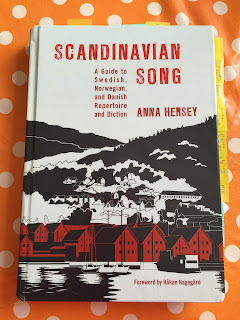A few years ago on The Diction Police podcast, we published episodes on Swedish and Norwegian Lyric Diction--I was eager to delve into them, because at the time there were very few resources available for singers in these languages. After the Swedish podcasts aired, Anna Hersey sent me an excellent article that she had written for the NATS Journal of Singing entitled "An Introduction to Swedish Diction", which was the basis for her doctoral dissertation. The moment she announced that she would be writing a diction book on all three of the Scandinavian languages, I waited not-so-patiently for the release date!
Now Scandinavian Song is out, and I've had the opportunity to work my way through it for the past few months with great pleasure. If you look closely at the above picture, you can see all the yellow post-its along the side--these mark all the information I want to be able to refer to at a glance! As you can see, there are a lot of them, because there is an incredible amount of information in this book.
The book is divided into three parts, which are all in turn divided into three sections (one for each language):
Part 1 covers the rules of lyric diction in Swedish, Norwegian, and Danish, with in-depth explanations of the vowels and consonants, how they are formed, and the standard performance practice of native-speaking performers, as well as the basic grammar necessary for understanding the rules. While on paper these languages appear to be exactly the same (to a foreign eye), there are major differences in the pronunciation of them, and each of these details is clearly defined and explained.
What I appreciate most about Part 1 is that Dr. Hersey discusses the new phonetic symbols that we need (like [ɶ] and [ʉ]) both with the regular linguistic definition and with a more colloquial, less formal explanation, which makes it accessible for all levels of diction study. She also gives step-by-step instructions on how to get started as a sort of checklist for those of us with little experience in the language, and in each language she recommends the best dictionaries and other resources to acquire as a reference to aid in further study.
Part 2 is a chronological list of composers for the repertoire of each language, along with stylistic and interpretive information for each song that is mentioned. The detail in this section is staggering--she discusses the setting and text in a way that reminds me of Pierre Bernac's Interpretation of French Song.
Part 3 has over 200 pages of phonetic transcriptions and poetic translations of songs, with background information on the poets. This book is worth having just for this portion! But I wouldn't recommend starting from this section--working through the first two parts of the book will lend a much better understanding of how to use the transcriptions effectively.
I've been working my way through Part 3 armed with YouTube--I find one or two clips of each song and listen while following along carefully. These are composers that I've seldom heard before, and it's been a wonderful way to get introduced to new repertoire, as well as the linguistic differences and musical languages of each country.
***
One of the greatest joys of lyric diction right now is that there is a great deal of research coming out on many languages besides the big three (Italian, German, and French). It's an exciting time, because we no longer have to sing the same repertoire in every recital, and Anna Hersey's book just opened up three new languages for us to program into performances! Scandinavian Song is a must-have in any reference library.
--Ellen




No comments:
Post a Comment